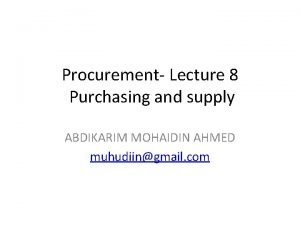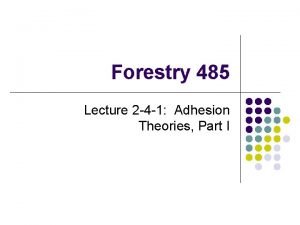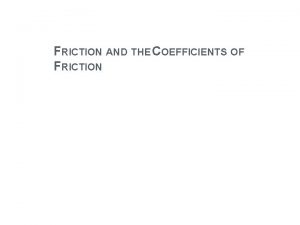ADHESION THEORY OF FRICTION Asst Prof Shehzad Ahmed






- Slides: 6

ADHESION THEORY OF FRICTION Asst. Prof. Shehzad Ahmed Mechanical Department Anjuman College of Engineering & Technology

INTRODUCTION • This theory is based on the fact that all surfaces are made of atoms. All atoms attract order one another by attractive force. • For examples, if we press steel piece over indium piece (as shown in Fig. 2. 9) they will bind across the region of contact. • This process is sometimes called "cold welding, " • It requires some force to separate the two surfaces. • If we now apply a sideways force to one of surfaces the junctions formed at the regions of real contact will have to be sheared if sliding is to take place. • The force to do this is the frictional force. Fig. 2. 10 shows carbon graphite material adhered to stainless steel shaft.

COLD WELDING Cold welding in steel and indium Carbon graphite and stainless steel.

THEORY OF ADHESIVE FRICTION • Bowden and Tabor developed theory of adhesive friction. • As per this theory on application of W, initial contact at some of higher asperity tips occurs. • Due to high stress those asperities suffer plastic deformation, which permits strong adhesive bonds among asperities. • Such cold formed junctions are responsible for the adhesive friction. • The real area of contact, A can be estimated by applied load W and hardness of the soft material, H. • If s is shear stress of softer material, then force Fa required to break these bonds can be estimated by Equation Fa = As. • The coefficient of friction due to adhesive friction is given by ratio of friction force to applied load W. Fig. 2. 11 shows the formulation and breakage of cold junctions.

• Two surfaces are pressed together under load W. • Material deforms until area of contact (A) is sufficient to support load W, A = W/H. • To move the surface sideway, it must overcome shear strength of junctions with force Fa. • μ = Fa ⁄ W = s ⁄ H.

• In other words shear strength(s) and hardness(H) of soft material decides the value of μ. This means whatever properties of the other harder pairing material, μ would not change. • For most of untreated materials H = 3 σy & s = σy/1. 7321. • Expected value of μ = 0. 2, as μ = s ⁄ H. • But for most of the material pair(shown in Fig. 2. 12) μ is greater than 0. 2. • There is a huge difference between measured values of friction coefficient and estimated by theory of adhesion. Theory is unable to estimate different μ for steel on indium and steel on lead alloy. Theory related to deformation needs to be explored.











